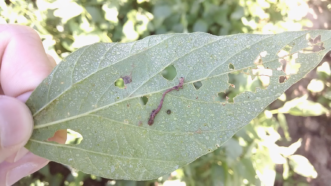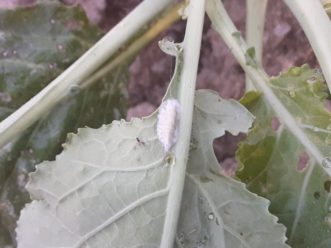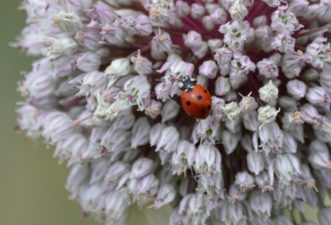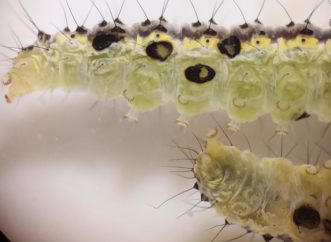Numerous species of natural enemies can be found in brassica fields preying on insect pests. This article describes common natural enemies and how they feed or develop on the pests they affect. Growers will benefit by being able to identify these natural enemies to assist in making pest management decisions.
Introduction
“Natural enemies” is a term used for naturally occurring, beneficial organisms that aid in maintaining pest species below damaging population levels. Utilizing natural enemies to manage pests is known as “biological control” and is an integral component of integrated pest management (IPM). An overview of an IPM program’s basic concepts is provided in the Land-Grant Press publication, Integrated Pest Management: Concepts and Strategies (bit.ly/3ov3soY). Natural enemies affect pest species through predation, parasitism, or by causing disease.1 Predators feed on other insects while parasitoids and pathogens develop on or within their host, usually killing it.2
Predators
Predatory Beetles
Ground beetles (figure 1) and tiger beetles (figure 2) (family Carabidae) are predatory beetles that are common throughout South Carolina. Carabids are long-legged, fast-moving beetles that move around on the ground, hunting for prey. They have keen eyesight and powerful mandibles (jaws) and may consume up to their body weight each day.2,3 Their prey includes caterpillars, aphids, and other beetle larvae and eggs. Several species also feed on small seeds of weeds such as ragweed, lambsquarters, crabgrass, and pigweed.4 Larvae generally develop in the soil and are also predaceous.5 This is one of the largest beetle families with 2,600 species in North America.3
Lady Beetles

Figure 3. Lady beetle larvae search for prey on the underside of a kale leaf. Image credit: Justin Ballew, Clemson Cooperative Extension.
Lady beetles (family Coccinellidae) are voracious predators of aphids and may eat several hundred per day1. Adults consume their prey whole while the larvae (figure 3) pierce and suck the internal contents from their prey.2 Lady beetles range in color from red to orange and have a variable number of spots on their back, depending on the species (figures 4 and 5). Though aphids are their preferred prey, lady beetles will also feed on scales, thrips, mites, mealybugs, and even insect eggs when aphid populations are sparse.1,2
Assassin Bugs and Predatory Stink Bugs

Figure 6. An assassin bug feeding on prey (at the tip of its mouthpart). Image credit: Justin Ballew, Clemson Cooperative Extension.
Assassin bugs (family Reduviidae) (figure 6) and predatory stink bugs (family Pentatomidae) (figures 7 and 8) have stout piercing/sucking mouthparts that they use to insert into their prey, inject digestive enzymes, and then suck out the bodily fluids. Predatory stink bugs and most species of assassin bugs actively search for prey, though some wait for prey to move within striking distance.6 Adults and nymphs primarily prey on caterpillars, beetle larvae, aphids, stink bugs, and flea beetles.1
Syrphid Flies
Syrphid flies (family Syrphidae) are small to medium-sized flies (figure 9) commonly mistaken for bees. Like bees, adults are frequent visitors of wildflowers, feeding on nectar and aiding in pollination.3 Syrphid fly larvae are blind, legless maggots (figure 10), though they are great predators that feed primarily on aphids. Female flies lay eggs near aphid colonies, allowing the larvae to hatch and easily feed on the nearby prey.
Spiders
Numerous species of spiders prey on insect pests, though some of the most common include lynx spiders (family Oxyopidae) (figure 11) and crab spiders (family Thomisidae) (figure 12). Neither builds a web to catch prey. Lynx spiders rely on their excellent eyesight, speed, and agility to hunt prey.7 Though helpful in managing numerous pests, they will readily prey on other beneficial species, including wasps, bees, other spiders, and parasitic flies. Due to their relatively small eyes, crab spiders usually do not spot prey from far away. They hunt by sitting still and waiting for prey to come within striking distance.8
Parasitoids
Parasitic Wasps

Figure 13. A tiny parasitic wasp rests on a collard leaf. Image credit: Justin Ballew, Clemson Cooperative Extension.
There are thousands of species of parasitic wasps (families Ichneumonidae, Braconidae, Trichogrammatidae, Encyrtidae, etc.); however, most go unnoticed due to their minute size (figure 13).2,4,8 Parasitic wasps use their ovipositors (stingers) to insert eggs into the bodies or eggs of caterpillars, aphids, and other insect pests. Once the eggs hatch, the wasp larvae feed on the host’s body, eventually boring out to pupate (figure 14) or pupating within the host and emerging as an adult (figures 15 and 16). This process usually kills the host. A tell-tale sign of an aphid parasitized by a wasp is the tan, hollow, bloated-looking carcass known as a “mummy” that is left behind once the wasp pupates (figures 16 and 17).

Figure 15. Copidosoma truncatellum is a parasitoid of cabbage loopers. It lays a single egg that divides multiple times (polyembryony), eventually filling the caterpillar’s entire body with larvae (pictured above). The larvae pupate within the host’s body and emerge as adults.8 (15x magnification) Image credit: Justin Ballew, Clemson Cooperative Extension.
Parasitic Flies
Parasitic flies (family Tachinidae) (figure 18) lay eggs on the outside of a host’s body, usually on or near the head (figure 19). Once the egg hatches, the larva bores into the host’s body to feed.3 Some species gain entry to the host’s body by laying eggs on leaf surfaces where they are inadvertently eaten. Like parasitic wasps, parasitic flies exit the host’s body to pupate, usually killing the host. Tachinid flies parasitize caterpillars, true bugs, grasshoppers, beetle larvae, and others.1,2,3,8
Pathogens
Viruses

Figure 20. This caterpillar has succumbed to a virus and is hanging from the bottom of a bean leaf. Image credit: Justin Ballew, Clemson Cooperative Extension.
Viruses such as the nuclear polyhedrosis virus (NPV) and granulosis virus mainly affect caterpillar pests. They often occur naturally at low levels in caterpillar populations but may cause severe disease outbreaks when population levels are high. Viral infection mainly occurs when caterpillars inadvertently eat infectious viral particles as they forage. The virus replicates within the caterpillar’s body, killing it within three to eight days.9 Infected caterpillars turn white or dark-colored, cease feeding, and die. Once dead, the caterpillar hangs limply from the underside of the host plant’s leaves or stems (figure 20), where viral particles fall onto lower leaves to be eaten by other caterpillars.
Fungi

Figure 21. Beauveria bassiana has colonized this diamondback moth caterpillar’s body, and thousands of white-colored spores are being produced. Image credit: Justin Ballew, Clemson Cooperative Extension.
Beauveria bassiana is a common entomopathogenic fungus that causes white muscardine disease. It affects a wide range of insects and has been utilized as an active ingredient in numerous biological insecticides. Infection occurs when fungal spores, called conidia, adhere to the insect’s outer cuticle. The conidia germinate and grow through the cuticle, allowing the fungus to colonize the inner body and feed on the internal tissue.10 Infected insects die within three to seven days. Once dead, white-colored fungal growth develops outside the host’s body (figure 21), producing infectious conidia to be dispersed by the wind or splashing rain.11 Pathogenic fungi have their most significant effect on insect populations when environmental conditions are damp or humid.2,8
Promoting Biological Control

Figure 22. Strips of sweet alyssum have been planted to attract parasitoids. Natural enemy habitat may be planted on field edges or within the field, as pictured here. Image credit: Justin Ballew, Clemson Cooperative Extension.
Biological control may be promoted by avoiding the use of broad-spectrum insecticides, such as carbamates (IRAC Group 1A), organophosphates (Group 1B), pyrethroids (Group 3A), and neonicotinoids (Group 4A), unless absolutely necessary.2,8 Broad-spectrum insecticides kill beneficial insects and spiders in addition to targeted pests. Instead, use materials that are less damaging to natural enemy populations whenever available.
Improving natural enemy habitat by planting a variety of wildflowers is another good way to promote biological control. Many parasitic flies and wasps feed on pollen and nectar as adults; therefore, providing a food source near crop fields may improve predation and parasitism of pest species. Parasitoids travel between the flowers and the crop to forage and lay eggs in or on pests. Species with small flowers such as sweet alyssum (figure 22), buckwheat, cilantro, fennel, and dill are particularly attractive to parasitoids.
References Cited
- Hoffman MP, Frodsham AC. Natural enemies of vegetable insect pests. Ithaca (NY): Cornell University; 1993.
- Flint ML, Dreistadt SH. Natural enemies handbook: the illustrated guide to biological pest control. Richmond (CA): University of California Press; 2016.
- Triplehorn CA, Johnson NF. Borror and DeLong’s introduction to the study of insects. 7th ed. Belmont (CA): Brooks/Cole; 2005.
- Lundgren JG. 2005. Ground beetles as weed control agents: effects of farm management on granivory. American Entomology. 2005 Oct; 51: 224-226. https://extension.psu.edu/ground-and-tiger-beetles-coleoptera-carabidae.
- Capinera JL. Handbook of vegetable pests. 2nd ed. San Diego (CA): Academic Press; 2020.
- Resh VH, Carde RT. Encyclopedia of insects. San Diego (CA): Academic Press; 2003.
- Weems Jr. HV, Whitcomb WH. Green lynx spider. Gainesville (FL): University of Florida. IFAS, Featured Creatures; Feb 2021. EENY-249. https://entnemdept.ufl.edu/creatures/beneficial/green_lynx_spider.htm.
- Mahr DL, Ridgway NM. Biological control of insects and mites. Madison (WI): University of Wisconsin Cooperative Extension Publications; 1993.
- Biological Control. Viruses. Ithaca (NY): Cornell University. https://biocontrol.entomology.cornell.edu/pathogens/viruses.php.
- Groden E, Boucher TJ. Using Beauveria bassiana for insect management. Integrated Pest Management Program. Storrs (CT): University of Connecticut; 2012. https://ipm.cahnr.uconn.edu/using-beauveria-bassiana-for-insect-management.
- Brack DJ. Dynamics of the fungus Beauveria bassiana [pdf]. Ames (IA): Iowa State University; 2001. p. 1–91. https://lib.dr.iastate.edu/cgi/viewcontent.cgi?article=1417&context=rtd.
Additional Resources
Bryant T, Reay-Jones FPF. Integrated pest management: concepts and strategies. Clemson (SC): Clemson Cooperative Extension, Land Grant Press by Clemson Extension; 2020 May. LGP 1051. https://lgpress.clemson.edu/publication/integrated-pest-management-concepts-and-strategies/
Ballew JB. Identification of common insect pests of brassica crops. Clemson (SC): Clemson Cooperative Extension, Land Grant Press by Clemson Extension; 2021 Sept. LGP 1122. https://lgpress.clemson.edu/publication/identification-of-common-insect-pests-of-brassica-crops/.
Ballew JB. Scouting for insect pests in brassica crops. Clemson (SC): Clemson Cooperative Extension, Land-Grant Press by Clemson Extension; 2021. LGP 1127. http://lgpress.clemson.edu/publication/identification-of-common-insect-pests-of-brassica-crops/.
















